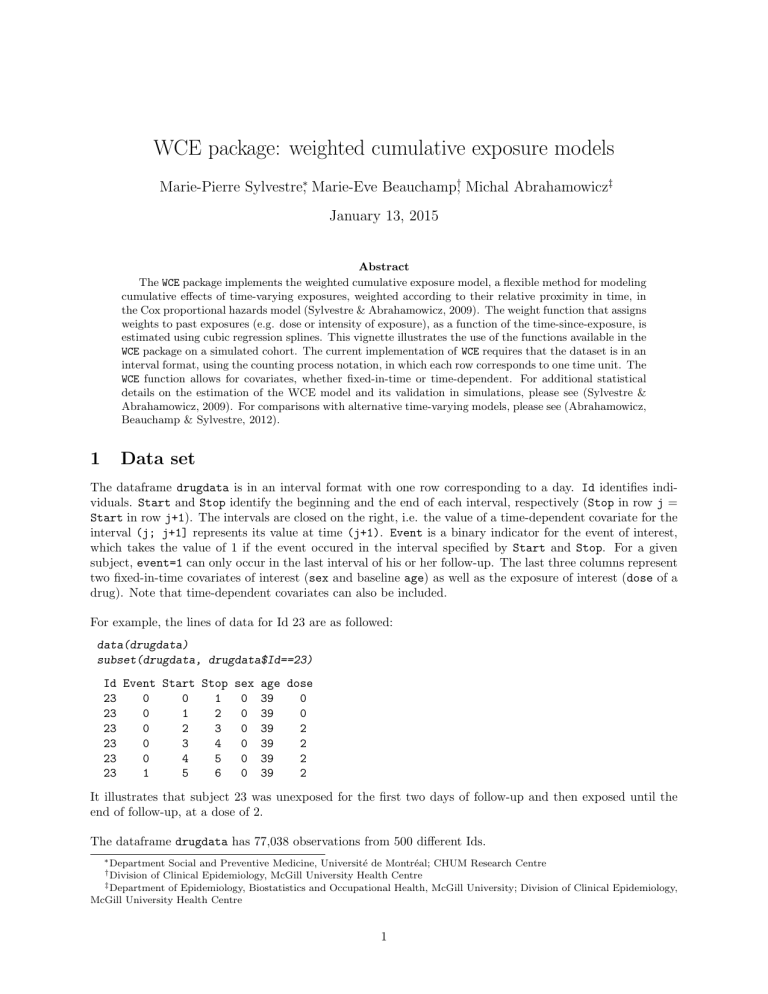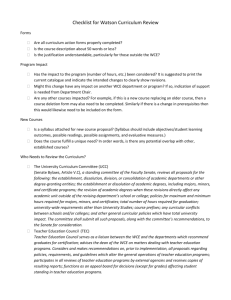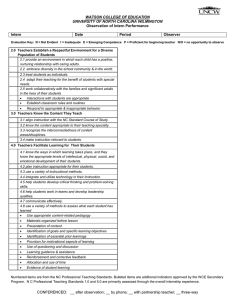WCE package: weighted cumulative exposure models

WCE package: weighted cumulative exposure models
Marie-Pierre Sylvestre
∗
, Marie-Eve Beauchamp
†
, Michal Abrahamowicz
‡
January 13, 2015
Abstract
The WCE package implements the weighted cumulative exposure model, a flexible method for modeling cumulative effects of time-varying exposures, weighted according to their relative proximity in time, in the Cox proportional hazards model (Sylvestre & Abrahamowicz, 2009). The weight function that assigns weights to past exposures (e.g. dose or intensity of exposure), as a function of the time-since-exposure, is estimated using cubic regression splines. This vignette illustrates the use of the functions available in the
WCE package on a simulated cohort. The current implementation of WCE requires that the dataset is in an interval format, using the counting process notation, in which each row corresponds to one time unit. The
WCE function allows for covariates, whether fixed-in-time or time-dependent. For additional statistical details on the estimation of the WCE model and its validation in simulations, please see (Sylvestre &
Abrahamowicz, 2009). For comparisons with alternative time-varying models, please see (Abrahamowicz,
Beauchamp & Sylvestre, 2012).
1 Data set
The dataframe drugdata is in an interval format with one row corresponding to a day.
Id identifies individuals.
Start and Stop identify the beginning and the end of each interval, respectively ( Stop in row j =
Start in row j+1 ). The intervals are closed on the right, i.e. the value of a time-dependent covariate for the interval (j; j+1] represents its value at time (j+1) .
Event is a binary indicator for the event of interest, which takes the value of 1 if the event occured in the interval specified by Start and Stop . For a given subject, event=1 can only occur in the last interval of his or her follow-up. The last three columns represent two fixed-in-time covariates of interest ( sex and baseline age ) as well as the exposure of interest ( dose of a drug). Note that time-dependent covariates can also be included.
For example, the lines of data for Id 23 are as followed: data(drugdata) subset(drugdata, drugdata$Id==23)
Id Event Start Stop sex age dose
23 0 0 1 0 39 0
23
23
23
23
23
0
0
0
0
1
1
2
3
4
5
2
5
6
0
0
0
39
3 0 39
4 0 39
39
39
0
2
2
2
2
It illustrates that subject 23 was unexposed for the first two days of follow-up and then exposed until the end of follow-up, at a dose of 2.
The dataframe drugdata has 77,038 observations from 500 different Ids.
∗
†
Division of Clinical Epidemiology, McGill University Health Centre
‡
Department of Epidemiology, Biostatistics and Occupational Health, McGill University; Division of Clinical Epidemiology,
McGill University Health Centre
1
nrow(drugdata)
[1] 77038 length(unique(drugdata$Id))
[1] 500
The start times for each Id corresponds to 0: table(by(drugdata$Start, drugdata$Id, min))
0
500
The current implementation of the WCE function does not allow the use of cohorts with delayed entry. While the start times do not have to correspond to 0, they have to be the same for all users.
In the dataframe drugdata , the maximum length of follow-up is 365: max(drugdata$Stop)
[1] 365
There are no missing values in the dataframe: apply(is.na(drugdata)==1, 2, sum)
Id Event Start Stop sex age dose
0 0 0 0 0 0 0
Note that the current implementation of WCE does not allow for missing data in the variables Id , Start ,
Stop , Event and expos .
The exposure can take 6 different values and varies over time: table(drugdata$dose)
0 0.5
1 1.5
2 2.5
3
49460 4683 3978 5118 4609 4674 4516
2 Estimation of the weighted cumulative exposure model
2.1
Preparing the input for WCE
The function WCEcheck allows users to verify that the arguments passed to the WCE function are correctly specified, to avoid errors: checkWCE(drugdata, id = "Id", event = "Event", start = "Start", stop = "Stop", expos = "dose")
Data are in the right format for WCE estimation.
Arguments include a dataframe drugdata and the name of the variables required for WCE .
id corresponds to the variable identifying subjects, event corresponds to an event indicator that must be coded 1 = event and
0 = no event, start corresponds to the variable identifying the starting time for the interval, stop corresponds to the variable identifying the ending time for each interval, and expos corresponds to the exposure variable. Note that start and stop respectively correspond to the time and time2 arguments in function
Surv in survival package. Covariates are excluded from calls to the WCEcheck function.
In cases in which the dataframe drugdata is not set up properly, for example if the exposure is mislabeled
(e.g.
drug instead of dose ), then checkWCE returns an (hopefully) informative error message:
2
checkWCE(drugdata, id = "Id", event = "Event", start = "Start", stop = "Stop", expos = "drug")
At least one of id, event, start, stop, or expos is missing from the dataset supplied.
It might be advantageous to run checkWCE before estimating the WCE model as error messages from checkWCE tend to be more informative than those of WCE and WCE is significantly more computationally intensive than checkWCE for large data sets.
2.2
Estimating WCE
The function WCE estimates the weighted cumulative exposure model described in Sylvestre & Abrahamowicz
(2009).
wce.obj <- WCE(data = drugdata, analysis = "Cox", nknots = 1:3, cutoff = 90, constrained = "R", int.knots = NULL, aic = FALSE, MatchedSet = NULL, id = "Id", event = "Event", start = "Start", stop = "Stop", expos = "dose", covariates = c("sex", "age"))
The arguments drugdata , id , event , start and stop are the same as those of the function WCEcheck described above. The second argument of WCE , analysis , needs to be set to "Cox" to estimate the WCE within the proportional hazards model, as illustrated in Sylvestre & Abrahamowicz (2009). It is currently the only model implemented in the WCE package. Extensions to other models or designs such as the nested case-control are under development.
Arguments nknots , cutoff , constrained and int.knots
specify features of the weight function to be estimated.
nknots determines the number of interior knots for the spline function estimating the weight function. Notation 1:3 implies that 3 alternative weight functions with respectively 1,2 and 3 interior knots will be estimated. Based on our experience, it is unlikely that > 3 knots will be useful and often, especially for datasets with < 200 events, 1 or 2 knots are sufficient. Notation 1:1 indicates that only 1 knot is considered.
cutoff specifies the length in time units for the window to which the weight function corresponds (see section
2.2 of (Sylvestre & Abrahamowicz, 2009) for details).
constrained indicates whether the weight function should be constrained or not (see section 2.3 of (Sylvestre & Abrahamowicz, 2009) for details). Weight functions can either be constrained to go smoothly to zero on the right, which corresponds to exposures remote in time ( constrained = "R" ) or on the left, which corresponds to recent exposures ( constrained
="L" ).
int.knots
specify whether the user wants the interior knots to be placed at user-specified values
(e.g.
int.knots = c(15,30,60) indicates the values of the 3 interior knots) or selected by the WCE function, which places the knots at quantiles across the time window ( int.knots = NULL ).
aic is a logical parameter. If set to TRUE , then the AIC is used to select the best fitting model among those estimated. If set to FALSE , then the BIC is used instead of the AIC. The default corresponds to FALSE
(BIC). Note that the BIC implemented in WCE is the version suggested by Volinsky and Raftery in Biometrics
(2000), which corresponds to BIC = 2 log( P L ) + p log( d ) where PL is the model’s partial log-likelihood, p is the number of estimated parameters and d is the the number of uncensored events. See Sylvestre and
Abrahamowicz (2009) for more details.
MatchedSet is an argument strictly related to the nested case-control option of the argument analysis , which remains to be implemented. Thus, for the current implementation, it has to be always set to
NULL . The argument covariates is used to indicate the names of the covariates to be included in the models.
The function WCE returns a WCE object for which print , plot and summary methods exist.
The print method associated with the WCE object generated by the call to the WCE function above returns the following information. Note that for each row of the matrix reporting the estimated WCE function, the consecutive columns show the estimated values of the weight functions for each day within the time window, from t1 (1 day elapsed) to the cutoff window (here t90 or 90 days in the past).
3
wce.obj
Estimated right-constrained WCE function(s).
t1 t2 t3 t4 t5 t6 t7 t8
1 knot(s) 0.03288 0.03157 0.03032 0.02912 0.02797 0.02688 0.02583 0.02483
2 knot(s) 0.02155 0.02286 0.02393 0.02480 0.02546 0.02592 0.02621 0.02633
3 knot(s) 0.03843 0.03479 0.03162 0.02887 0.02653 0.02456 0.02293 0.02162
...
t89 t90
1 knot(s) 1.853e-05 2.660e-06
2 knot(s) 6.625e-05 9.555e-06
3 knot(s) 1.799e-04 2.604e-05
Number of events:
[1] 383
Partial log-Likelihoods:
1 knot(s) 2 knot(s) 3 knot(s)
[1,] -1896.541 -1894.843 -1892.303
BIC:
[,1] [,2] [,3]
[1,] 3823.821 3825.375 3826.242
Matrix of coefficients estimates for the covariates: sex age
1 knot(s) 0.6805 0.01144
2 knot(s) 0.6844 0.01144
3 knot(s) 0.6901 0.01151
Matrix of standard error estimates for the covariates: sex age
1 knot(s) 0.1187 0.003969
2 knot(s) 0.1188 0.003968
3 knot(s) 0.1189 0.003974
If you report these results, please cite
Sylvestre MP, Abrahamowicz M. Flexible Modeling of the Effects of Time-Dependent Exposures on the Hazard. Statistics in Medicine 2009; 28(27):3437-3453.
3 Methods for WCE objects
Summary and plot methods are available for the WCE object produced by the function WCE .
3.1
Summary
The default option of the summary method for the WCE object selects the best model estimated by the WCE function if the user specified more than 1 value for the number of interior knots using the nknots argument.
The summary method provides the coefficients estimates for the covariates (if any) included in the WCE model, the values of the partial log-likelihood, the BIC or AIC (depending on what the user specified), and the number of events used in the estimated model(s).
4
summary(wce.obj)
*** Right-constrained estimated WCE function (Proportional hazards model).***
Estimated coefficients for the covariates: coef exp(coef) se(coef) z p sex 0.6805
age 0.0114
1.975
1.012
0.1187 5.731 0.000
0.0040 2.881 0.004
Partial log-likelihood: -1896.542
BIC: 3823.821
Number of events: 383
Use plot(wce.obj) to see the estimated weight function corresponding to this model.
If you report these results, please cite
Sylvestre MP, Abrahamowicz M. Flexible Modeling of the Effects of Time-Dependent Exposures on the Hazard. Statistics in Medicine 2009; 28(27):3437-3453.
Alternatively, by setting allres = TRUE in the summary function, one can obtain the same information for each model (with different numbers of knots) estimated in the WCE function.
3.2
Plot
A plot method exists for WCE objects. Figure 1 shows the results of plot(wce.obj) , which corresponds to the plot of the best-fitting estimated weight function (here with 1 interior knot, corresponding to the minimum BIC).
Similarly to the summary method, the default setting for plot is to plot the best fitting model as determined by BIC or AIC. A single plot of all fitted models can be obtained using plot(wce.obj, allres
= TRUE) , as shown in Figure 2.
4 Obtaining hazard ratios for a WCE model
To facilitate interpretation of the WCE model results, the user may use the HR.WCE
function to obtain estimates of the hazard ratio (HR), adjusted for the covariates included in the model. A HR can be obtained from a WCE model by comparing any two (arbitrarily selected) exposure vectors or exposure scenarios (e.g.
dosing regimens in the case of drug studies). Scenarios are represented by vectors of the same length as the window value selected in the WCE estimation (cutoff) and indicate the value of exposure (e.g. drug dose) at each time units within the window. The first value of the vector represents the exposure today (t1) and subsequent values represent the exposures in the past (e.g. at 1, 2, ... up to 90 days ago, i.e. at t1,...t90).
Selected examples are presented here, using the HR.WCE
function and assuming cut-off = 90 days.
Example 1: Comparing continuous users (with exposure = 1 at each of the past 90 days ) vs.
non-users (exposure = 0 for the past 90 days): nonusers <- rep(0, 90) users <- rep(1, 90)
# for all models
HR.WCE(wce.obj, users, nonusers, allres = TRUE)
HR
1 knot(s) 2.496
2 knot(s) 2.620
3 knot(s) 2.825
5
Best−fitting estimated weight function
1 knots(s) (BIC=3822.82)
0 20 40
Time elapsed
60 80
Figure 1: Plot of the best-fitting weight function in a WCE object
# for the best model only
HR.WCE(wce.obj, users, nonusers)
[,1]
[1,] 2.496
The above estimate indicates that subjects exposed to 1 mg dose of the drug across past 90 days have about
2.5 higher hazard than those who did not use the drug at all in the past 90 days.
Example 2: Comparing high exposure (dose = 2, for the past 90 days) to light exposure (dose
= 0.5, for the past 90 days): light <- rep(0.5, 90) heavy <- rep(2, 90)
HR.WCE(wce.obj, heavy, light, allres = TRUE)
HR
1 knot(s) 3.944
2 knot(s) 4.241
3 knot(s) 4.747
6
Estimated weight functions
Best fit indicated with solid circles
1 knots(s) , BIC = 3822.82
2 knots(s) , BIC = 3825.37
3 knots(s) , BIC = 3826.24
0 20 40
Time elapsed
60 80
Figure 2: Plot of all of the alternative estimated weight functions (with 1 to 3 interior knots) in a WCE object
Example 3: Comparing current use (dose = 1 for 30 the past days) to past use in a more distant past (dose = 1 for 30 days from but 90 to 60 days ago): past <- c(rep(0, 60), rep(1, 30)) current <- c(rep(1, 30), rep(0, 60))
HR.WCE(wce.obj, current, past, allres = TRUE)
HR
1 knot(s) 1.727
2 knot(s) 1.597
3 knot(s) 1.479
Example 4: Comparing different dose and timings: subject 1 (s1: dose = 2 for most recent 10 days, dose = 0 for 50 days (from 60 to 11 days ago), dose = 1 for 30 days (from 90 to 61 days ago) versus subject 2 (s2: dose = 0 for most recent 30 days, dose = 1.5 for 20 days (from 50 to 31 days ago), dose = 0.5 for 40 days (from 90 to 51 days ago): s1 <- c(rep(2, 10), rep(0, 50), rep(1, 30)) s2 <- c(rep(0, 30), rep(1.5, 20), rep(0.5, 40))
7
HR.WCE(wce.obj, s1, s2, allres = TRUE)
HR
1 knot(s) 1.294
2 knot(s) 1.386
3 knot(s) 1.627
5 Bootstrap function to obtain pointwise confidence intervals
Confidence intervals for HRs calculated in the previous section, as well as pointwise confidence bands for the estimated weight function, can be obtained via bootstrap. A simple example is given below. More sophisticated bootsrap routines may be used for optimal results.
Set the number of bootstrap resamples (set to 5 for demonstration purposes only, in actual analyses should be much higher, preferably at least 300, minimum B = 100):
B <- 5
Obtain the list of Id for sampling:
ID <- unique(drugdata$Id)
Prepare vectors to extract estimated weight function and (if relevant) HRs for each bootstrap resample: boot.WCE <- matrix(NA, ncol = 90, nrow = B) # To store estimated weight functions boot.HR <- rep(NA, B) # to store estimated HRs
Sample IDs with replacement: for (i in 1:B){ datab <- drugdata[drugdata$Id %in% sample(ID, replace = T),] # select obs. in bootstrap sample mod <- WCE(data = datab, analysis = "Cox", nknots = 1:3, cutoff = 90, constrained = "R", int.knots = NULL, aic = FALSE, MatchedSet = NULL, id = "Id", event = "Event", start = "Start", stop = "Stop", expos = "dose", covariates = c("sex", "age"))
# return best WCE estimates and corresponding HR best <- which.min(mod$info.criterion) boot.WCE[i,] <- mod$WCEmat[best,] boot.HR[i] <- HR.WCE(mod, rep(1,90), rep(0, 90))}
Summarize bootstrap results using percentile method to obtain a 90% confidence interval:
# estimated weight functions apply(boot.WCE, 2, quantile, p = c(0.05, 0.95))
[,1] [,2] [,3] [,4] [,5] [,6] [,7] [,8] [,9]
5% 0.01907 0.01889 0.01870 0.01851 0.01832 0.01798 0.01748 0.01700 0.01654
95% 0.03848 0.03671 0.03503 0.03343 0.03191 0.03046 0.02909 0.02779 0.02657
[,10] [,11] [,12] [,13] [,14] [,15] [,16] [,17] [,18]
5% 0.01610 0.01567 0.01526 0.01487 0.01444 0.01403 0.01364 0.01325 0.01282
95% 0.02541 0.02432 0.02329 0.02233 0.02142 0.02057 0.01986 0.01923 0.01865
...
8
[,83] [,84] [,85] [,86] [,87] [,88] [,89] [,90]
5% 0.0003246 0.0002467 0.0001788 0.0001211 7.426e-05 3.852e-05 1.432e-05 2.056e-06
95% 0.0006193 0.0004715 0.0003422 0.0002323 1.426e-04 7.411e-05 2.759e-05 3.962e-06
# estimated HR quantile(boot.HR, p = c(0.05, 0.95))
5% 95%
1.991 2.895
6 Other methods of interest
Finally, the following three methods may be useful to extract several parameters from a WCE object. First, the coef method can be used to obtain the estimated regression coefficients for models estimated by the WCE routine. It provides both the coefficients of the so-called artificial time-dependent variables D in Sylvestre and Abrahamowicz (2009), as well as the estimated coefficients for the covariates (if any).
coef.WCE(wce.obj)
$WCEest
D1 D2
1 knots(s) 0.03565 0.012925
D3
0.01089
NA
2 knots(s) 0.01827 0.037901 -0.00639
0.01777
NA
NA
3 knots(s) 0.04713 0.008394
0.03360 -0.01411 0.02696
$covariates sex age
1 knot(s) 0.6805 0.01144
2 knot(s) 0.6844 0.01144
3 knot(s) 0.6901 0.01151
Similarly, the vcov method returns the variance-covariance matrix of the estimated regression coefficients: vcov.WCE(wce.obj)
$
`
1 knots(s)
` sex age D1 D2 D3 sex 1.410e-02 -1.492e-05 2.170e-05 -7.602e-06 6.563e-05 age -1.492e-05 1.575e-05 8.831e-07 -1.228e-06 1.718e-06
D1 2.170e-05 8.831e-07 1.080e-04 -7.625e-05 4.269e-05
D2 -7.602e-06 -1.228e-06 -7.625e-05 9.258e-05 -6.528e-05
D3 6.563e-05 1.718e-06 4.269e-05 -6.528e-05 7.354e-05
$
`
2 knots(s)
` sex age D1 D2 D3 D4 sex 1.412e-02 -1.458e-05 6.825e-06 1.769e-05 1.150e-05 4.721e-05 age -1.458e-05 1.574e-05 1.301e-06 -1.051e-06 4.909e-07 7.694e-07
D1 6.825e-06 1.301e-06 2.534e-04 -1.616e-04 8.764e-05 -4.330e-05
D2 1.769e-05 -1.051e-06 -1.616e-04 1.599e-04 -1.055e-04 5.030e-05
D3 1.150e-05 4.909e-07 8.764e-05 -1.055e-04 1.126e-04 -6.393e-05
D4 4.721e-05 7.694e-07 -4.330e-05 5.030e-05 -6.393e-05 6.234e-05
$
`
3 knots(s)
` sex age D1 D2 D3 D4 D5
9
sex 1.414e-02 -1.424e-05 4.577e-05 -2.002e-05 4.662e-05 6.970e-06 4.890e-05 age -1.424e-05 1.579e-05 1.866e-06 -9.165e-07 -1.550e-08 6.185e-07 6.041e-07
D1 4.577e-05 1.866e-06 5.430e-04 -3.194e-04 1.708e-04 -8.106e-05 4.107e-05
D2 -2.002e-05 -9.165e-07 -3.194e-04 2.699e-04 -1.719e-04 8.250e-05 -4.551e-05
D3 4.662e-05 -1.550e-08 1.708e-04 -1.719e-04 1.656e-04 -9.531e-05 5.215e-05
D4 6.970e-06 6.185e-07 -8.106e-05 8.250e-05 -9.531e-05 9.224e-05 -5.698e-05
D5 4.890e-05 6.041e-07 4.107e-05 -4.551e-05 5.215e-05 -5.698e-05 7.097e-05
Finally, when the knot placement is not specified by the user but rather selected by the WCE routine, it can be obtained from the WCE object by using the knots method: knots.WCE(wce.obj)
$
`
1 knots(s)
`
[1] -3 -2 -1 0 46 90 91 92 93
$
`
2 knots(s)
`
[1] -3 -2 -1 0 31 60 90 91 92 93
$
`
3 knots(s)
`
[1] -3 -2 -1 0 23 46 68 90 91 92 93
7 References
Sylvestre MP, Abrahamowicz M. Flexible Modeling of the Effects of Time-Dependent Exposures on the Hazard. Statistics in Medicine 2009; 28(27):3437-3453.
Abrahamowicz M, Beauchamp ME, Sylvestre MP. Comparison of alternative models for linking drug exposure with adverse effects. Statistics in Medicine 2012; 31(11-12): 1014-1030.
Volinsky CT, Raftery AE. Bayesian information criterion for censored survival models. Biometrics 2000;
56, 256-262.
10



